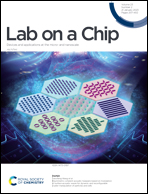Design and validation of a flowless gradient generating microfluidic device for high-throughput drug testing†
Abstract
Drug testing is a vital step in the identification of the potential efficacy of any new/existing drug and/or combinations of drugs. The conventional methods of testing the efficacy of new drugs using multiwell plates are time consuming and prone to evaporation loss and manual error. Microfluidic devices with automated generation of concentration gradients provide a promising alternative. The implementation of such microfluidic devices is still limited owing to the additional expertise and facilities required to fabricate and run these devices. Conventional microfluidic devices also need pumps, tubing, valves, and other accessories, making them bulky and non-portable. To address these problems, we have developed a method for fabricating microfluidic structures using a nonconventional technique by exploiting the Saffman–Taylor instability in lifted Hele-Shaw cells. Multi-channel structure molds with varying dimensions were fabricated by shaping ceramic polymer slurry and retaining the shape. Further using the mold thus made, polydimethyl siloxane (PDMS) devices offering static, stable, diffusion-based gradients were casted using soft lithography. We have demonstrated with COMSOL simulation, as well as using fluorescein isothiocyanate (FITC), a fluorescent dye, that the concentration gradient can be generated in this device, which remains stable for at least 5 days. Using this multichannel device, in vitro drug efficacy was validated with two drugs namely, temozolomide (TMZ) and curcumin, one FDA approved and one under research, on glioblastoma cells (U87MG). The resulting IC50 values were consistent with those reported in the literature. We have also demonstrated the possibility of conducting molecular assays post-drug testing in the device by microtubule staining after curcumin treatment on cervical cancer cells (HeLa). In summary, we have demonstrated a i) user-friendly, ii) portable, static drug testing platform that iii) does not require further accessories and can create iv) a stable gradient for a long duration. Such a device can reduce the time, manual errors, fabrication and running expenditure, and resources needed to a great extent in drug testing.



 Please wait while we load your content...
Please wait while we load your content...